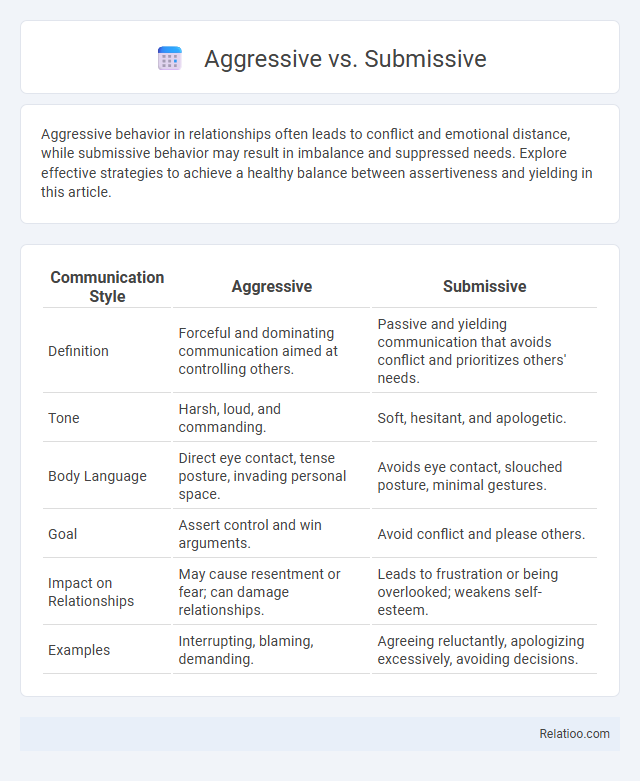Aggressive behavior in relationships often leads to conflict and emotional distance, while submissive behavior may result in imbalance and suppressed needs. Explore effective strategies to achieve a healthy balance between assertiveness and yielding in this article.
Table of Comparison
| Communication Style | Aggressive | Submissive |
|---|---|---|
| Definition | Forceful and dominating communication aimed at controlling others. | Passive and yielding communication that avoids conflict and prioritizes others' needs. |
| Tone | Harsh, loud, and commanding. | Soft, hesitant, and apologetic. |
| Body Language | Direct eye contact, tense posture, invading personal space. | Avoids eye contact, slouched posture, minimal gestures. |
| Goal | Assert control and win arguments. | Avoid conflict and please others. |
| Impact on Relationships | May cause resentment or fear; can damage relationships. | Leads to frustration or being overlooked; weakens self-esteem. |
| Examples | Interrupting, blaming, demanding. | Agreeing reluctantly, apologizing excessively, avoiding decisions. |
Understanding Aggressive and Submissive Behaviors
Understanding aggressive and submissive behaviors involves recognizing how individuals express dominance or deference in social interactions. Aggressive behavior is characterized by assertive actions aimed at controlling or winning, often through intimidation or confrontation, while submissive behavior reflects compliance, avoidance of conflict, and yielding to others' demands or authority. Your ability to interpret these behaviors accurately enhances communication, conflict resolution, and relationship dynamics in personal and professional settings.
Key Characteristics of Aggressive Communication
Aggressive communication is characterized by a forceful tone, dominating language, and disregard for others' feelings or opinions, often leading to conflict and defensiveness. You might notice intense eye contact, raised voice, and interrupting as common traits in aggressive communicators. Unlike submissive communication, which avoids confrontation, aggressive communication prioritizes winning over fostering mutual respect.
Key Characteristics of Submissive Communication
Submissive communication is characterized by a tendency to avoid expressing personal needs or opinions, often leading to passive behavior and a lack of assertiveness. Your message may come across as hesitant, indirect, or overly apologetic, which can result in others overlooking your desires or taking advantage of your compliance. Key traits include low confidence, difficulty saying no, and a focus on pleasing others at the expense of personal boundaries.
Psychological Roots of Aggression and Submission
Aggression often stems from psychological roots such as perceived threats, frustration, or unmet needs triggering a fight-or-flight response driven by the amygdala and limbic system. Submission, in contrast, may arise from learned helplessness, low self-esteem, or social conditioning that emphasizes compliance and fear of conflict, engaging the prefrontal cortex's regulation of social behavior. Understanding these contrasting behavioral responses involves analyzing neurobiological mechanisms, attachment styles, and environmental influences shaping individual coping strategies.
Impact of Aggressive Behavior in Relationships
Aggressive behavior in relationships often leads to frequent conflicts, emotional distress, and a breakdown in communication, creating an environment of fear and mistrust. This dominance-driven approach can stifle open dialogue, resulting in partners feeling undervalued and emotionally unsafe. Over time, persistent aggression may escalate into verbal or physical abuse, severely damaging the relationship's foundation and long-term stability.
Impact of Submissive Behavior in Relationships
Submissive behavior in relationships can significantly affect communication dynamics, often leading to unbalanced decision-making and unmet personal needs. Your consistent submissiveness may result in reduced self-esteem and increased resentment, as your desires and opinions are frequently overlooked. Recognizing and addressing these patterns is crucial for fostering mutual respect and emotional fulfillment between partners.
Social Perceptions: Aggression vs. Submission
Aggression is often perceived as a display of dominance and strength, signaling confidence and control in social interactions. Submission, in contrast, is seen as a sign of compliance or deference, which can be interpreted as weakness or a strategy to maintain peace. Social perception varies widely, with aggressive behavior sometimes admired for leadership qualities, while submissiveness may be respected for humility or criticized for passivity.
Consequences in the Workplace: Aggressive vs. Submissive Styles
Aggressive workplace behavior often leads to increased conflict, reduced collaboration, and higher turnover rates, negatively impacting team morale and productivity. Submissive styles may result in unmet needs, low assertiveness, and missed opportunities for feedback, causing employee frustration and stagnation. Balancing assertiveness is critical to fostering open communication, mutual respect, and effective problem-solving in professional environments.
Strategies for Achieving Healthy Assertiveness
Healthy assertiveness balances confidence and respect, ensuring clear communication without aggression or passivity. Strategies include expressing needs and boundaries calmly, practicing active listening to understand others, and using "I" statements to convey feelings without blame. Developing self-awareness and emotional regulation supports maintaining assertiveness while fostering positive relationships.
Transforming Extremes: Balancing Aggression and Submission
Transforming extremes of aggressive and submissive behavior requires recognizing the impact of both on your emotional well-being and relationships. Balancing assertiveness with empathy allows you to express needs confidently without overpowering others or feeling overwhelmed by passivity. Developing emotional intelligence and self-awareness is key to navigating between aggression and submission for healthier communication.

Infographic: Aggressive vs Submissive
 relatioo.com
relatioo.com